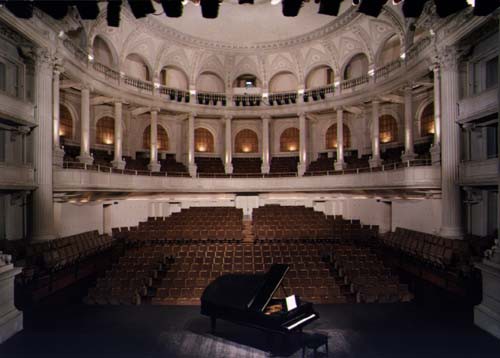It was with the aim of entertaining the imperial court during its sittings Compiègne and of providing a more spacious theatre than that built by Louis-Philippe, that Napoleon III decided in 1866 to build a more up-to-date and larger theatre. Located to the left-hand side of the palace (on a site once occupied by a Carmelite convent), the imperial theatre is linked to château by a covered gallery which forms a bridge over the road.
Construction began in 1867, under the supervision of the official government architect, Auguste-Gabriel Ancelet, who was already in charge of the Châteaux of Compiègne and Pau. Ancelet drew his inspiration from the Versailles opera house and from buildings by Palladio and Ledoux, and designed an architectural work typical of the Second Empire, namely: a metal frame and traditional materials (brick and stone) for the walls and interior decoration. And whilst Crauk (1827-1905) managed to complete the sculptures which are still in place today, the theatre never received any further interior decoration. The ceiling decoration to be done by Elie Delaunay (1828-1891) was never executed, nor was Faivre's decorative scheme for the boxes. The war of 1870 and the fall of the Empire were to put a definitive stop to the work.
Crauk's plaster casts are kept today at the Beaux-Arts Museum of Valenciennes, and Delaunay's preliminary drawings for the ceiling are in the museum of Nantes. Both are fine illustrations of Second Empire theatre decoration.
In 1987, the Compiégne Association 'Pour le Théâtre Impérial' was created in order to save the building and return it to its original purpose. Opened in September 1991, it is the home of the 'Théâtre Français de la Musique' whose mission it is foster interest in French opera; exactly the same reason for which Napoleon III founded the theatre. The auditorium, designed for 1100 people, and the 13m-wide stage, represent an exceptional ensemble, and there are many who claim that the acoustics are amongst the best in the world.
Compiègne Itinerary
Imperial Theatre of Compiègne


